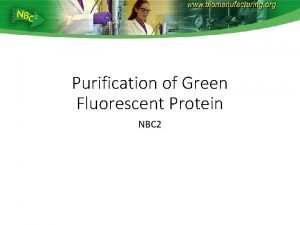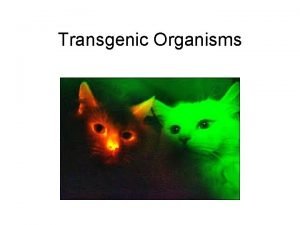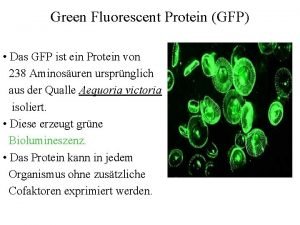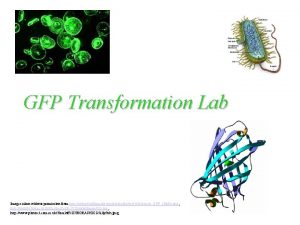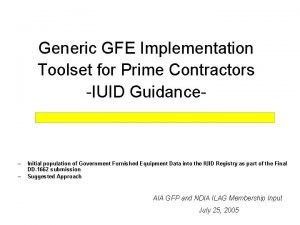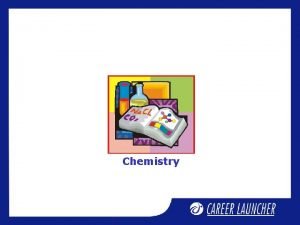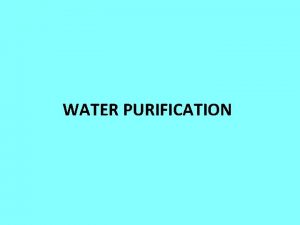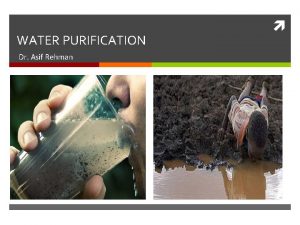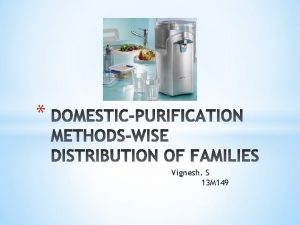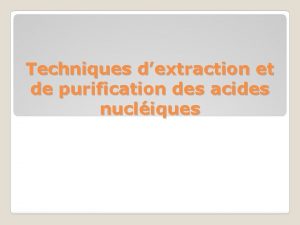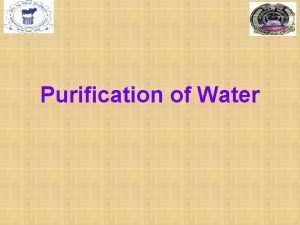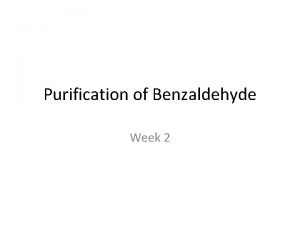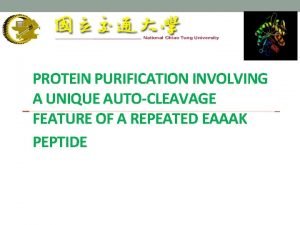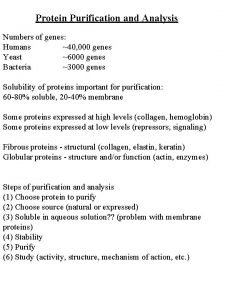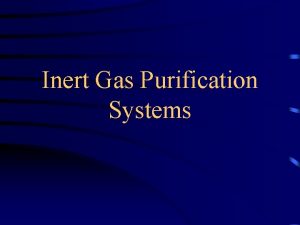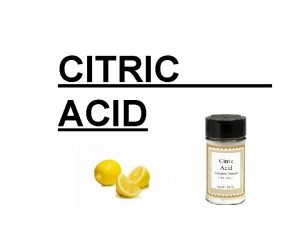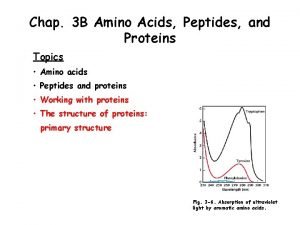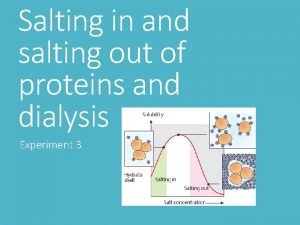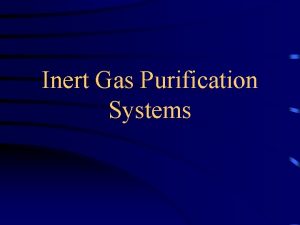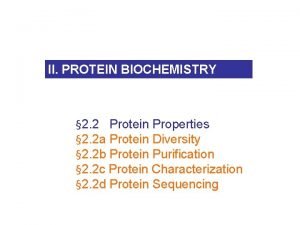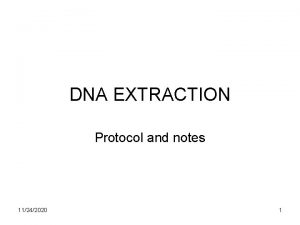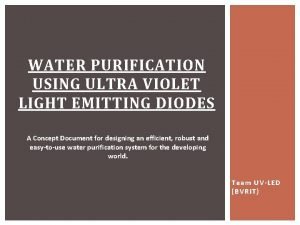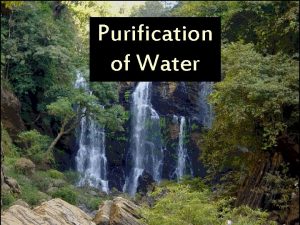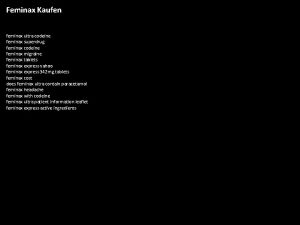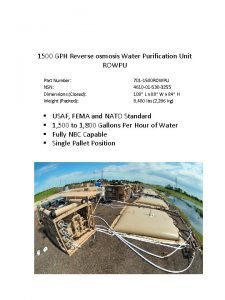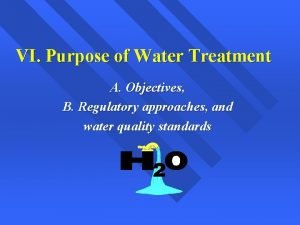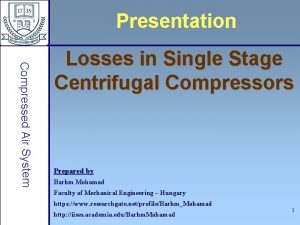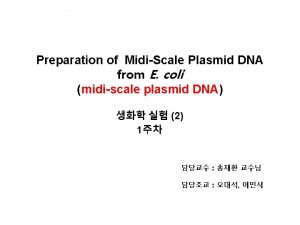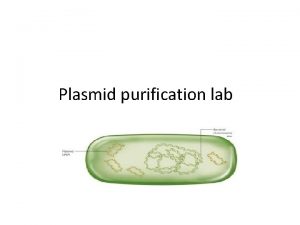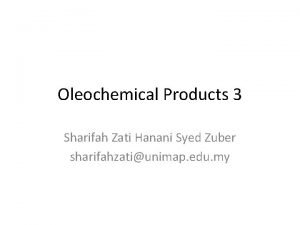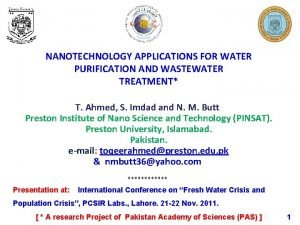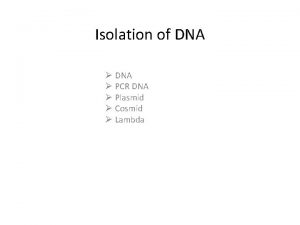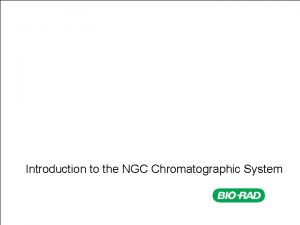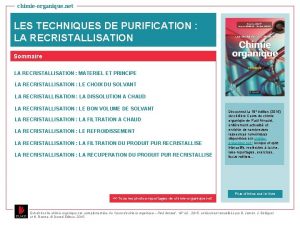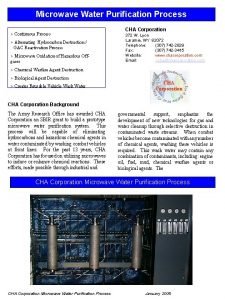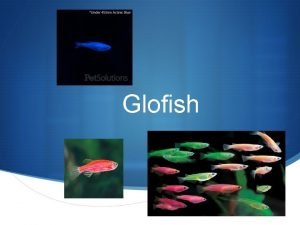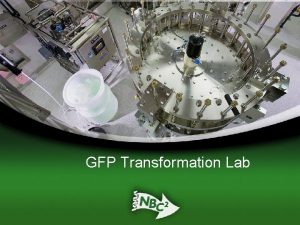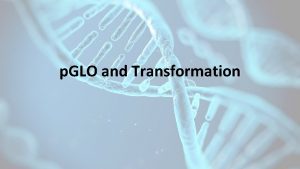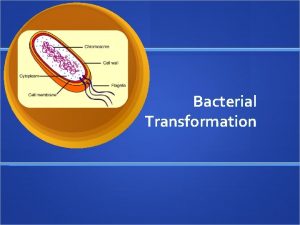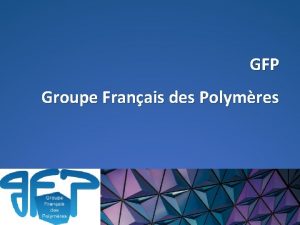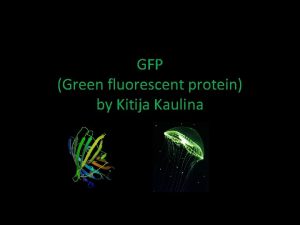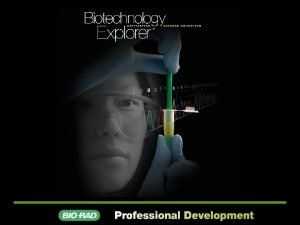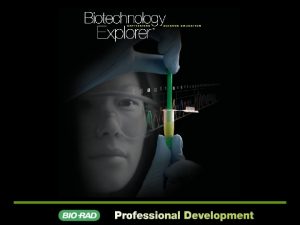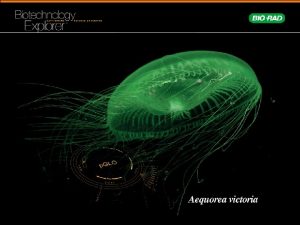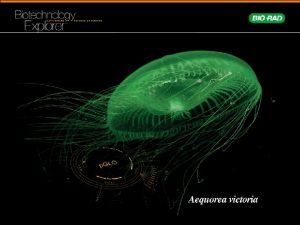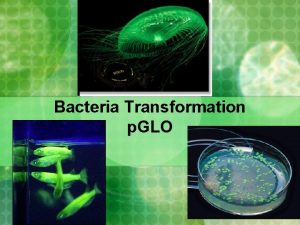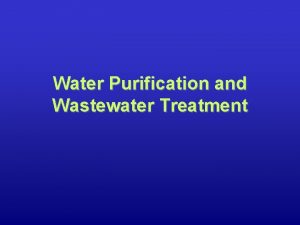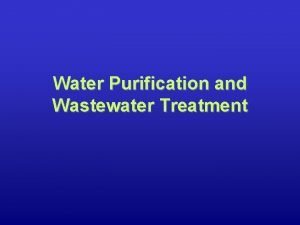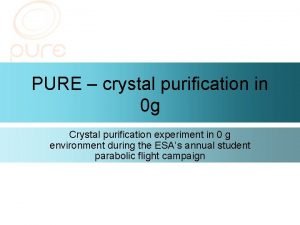p GLO GFP p GLO Transformation and Purification





































- Slides: 37


p. GLO™ & GFP

p. GLO™ Transformation and Purification of Green Fluorescent Protein (GFP) Instructors Stan Hitomi Director, Edward Teller Education Center UC Davis / Lawrence Livermore National Laboratory, Livermore, CA Kirk Brown Lead Instructor, Edward Teller Education Center Science Dept. Chair, Tracy High School and Delta College, Tracy, CA Sherri Andrews, Ph. D. North Carolina School of the Arts Winston-Salem, NC

Why Teach Bacterial Transformation and Protein Purification? • Powerful teaching tool • Meet national science standards • Laboratory extensions • Real-world connections • Link to careers and industry

Central Framework of Molecular Biology DNA RNA Protein Trait

Links to Real-world • GFP is a visual marker • Study of biological processes (example: synthesis of proteins) • Localization and regulation of gene expression • Cell movement • Cell fate during development • Formation of different organs • Screenable marker to identify transgenic organisms

p. GLO™ Bacterial Transformation Kit Bio-Rad p. GLO Kit Advantages • Standards-based • Comprehensive curricula for inquiry-based investigations • Compatible with 50 minute class periods • Serves entire class of 32 students (up to 4 students per group) • Cost-effective • Success in student’s hands • Safe • Striking results!

Green Fluorescent Protein (GFP) Chromatography Kit GFP Purification kit advantages • Links to real world science • Laboratory extensions • Tangible results • Leverages equipment • Amazing results

Transformation Procedure Day 1 Day 2

GFP Workshop Timeline • Introduction • Transform bacteria with p. GLO plasmid • Purify GFP using column chromatography

p. GLO Bacterial Transformation Kit

What is Transformation? • Uptake of foreign DNA, often a circular plasmid GFP Beta-lactamase Ampicillin Resistance

What is a plasmid? • A circular piece of autonomously replicating DNA • Originally evolved by bacteria • May express antibiotic resistance gene or be modified to express proteins of interest

The Many Faces of Plasmids Transmission electron micrograph Graphic representation Agarose gel

Protein Size • Beta Lactamase – Ampicillin resistance • Green Fluorescent Protein (GFP) – Aequorea victoria jellyfish gene • ara. C regulator protein – Regulates GFP transcription

Bacterial Transformation Cell wall GFP Bacterial chromosomal DNA Beta lactamase (ampicillin resistance) p. GLO plasmids

Bacterial DNA Bacterial cell Plasmid DNA Genomic DNA

Transcriptional Regulation • Lactose operon • Arabinose operon • p. GLO plasmid

Transcriptional Regulation ara Operon lac Operon Lac. I Z Y A ara. C Y A B A D RNA Polymerase Z A D Effector (Arabinose) Effector (Lactose) Lac. I B ara. C B A D

Gene Regulation ara GFP Operon ara. C B A D ara. C Effector (Arabinose) ara. C B A D ara. C RNA Polymerase ara. C B A D GFP Gene RNA Polymerase ara. C GFP Gene

Methods of Transformation • Electroporation – Electrical shock makes cell membranes permeable to DNA • Calcium Chloride/Heat-Shock – Chemically-competent cells uptake DNA after heat shock

Transformation Procedure • Suspend bacterial colonies in Transformation solution • Add p. GLO plasmid DNA • Place tubes in ice • Heat-shock at 42°C and place on ice • Incubate with nutrient broth • Streak plates

Reasons for Performing Each Transformation Step? Ca++ O O P O O CH 2 Base O Sugar 1. Transformation solution = Ca. CI 2 Positive charge of Ca++ ions shields negative charge of DNA phosphates O Ca++ O P O O CH 2 Base O Sugar OH

Why Perform Each Transformation Step? Cell wall GFP 2. Incubate on ice slows fluid cell membrane 3. Heat-shock Increases permeability of membranes 4. Nutrient broth incubation Allows beta-lactamase expression Beta-lactamase (ampicillin resistance)

What is Nutrient Broth? • Luria-Bertani (LB) broth • Medium that contains nutrients for bacterial growth and gene expression – Carbohydrates – Amino acids – Nucleotides – Salts – Vitamins

Grow? Glow? • Follow protocol • On which plates will colonies grow? • Which colonies will glow?

Volume Measurement

GFP Chromatography Kit

GFP Purification Procedures Day 1 Day 2 Day 3

Why Use Chromatography? • To purify a single recombinant protein of interest from over 4, 000 naturally occuring E. coli gene products.

Column Chromatography • Chromatography used for protein purification – Size exclusion – Ion exchange – Hydrophobic interaction

- - + - Hydrophobic bead + + + Hydrophobic Interactions + + - + + Aqueous solution = hydrophobic O -O S + O- - O + H H O - S O +N H - O High salt = hydrophobic

Hydrophobic Interaction Chromatography: Steps 1– 3 1. Add bacterial lysate to column matrix in high salt buffer 2. Wash less hydrophobic proteins from column in low salt buffer 3. Elute GFP from column with no salt buffer

Step 1: Hydrophobic Interaction Chromatography • Add bacterial lysate to column matrix in high salt buffer – Hydrophobic proteins interact with column

Step 2: Hydrophobic Interaction Chromatography • Wash less hydrophobic from column with low salt buffer – Less hydrophobic E. coli proteins fall from column – GFP remains bound to the column

Step 3: Hydrophobic Interaction Chromatography • Elute GFP from column by adding no salt buffer GFP – Released from column matrix – Flows through the column

Helpful Hints: Hydrophobic Interaction Chromatography • Add a small piece of paper to collection tube where column seats to insure column flow • Rest pipette tip on side of column to avoid column bed disturbance when adding solutions • Drain until the meniscus is just above the matrix for best separation
 Ion exchange chromatography
Ion exchange chromatography Gmo
Gmo Was ist gfp
Was ist gfp Total transformation lab
Total transformation lab Gfe vs gfp
Gfe vs gfp Protein characterization techniques
Protein characterization techniques Purification and characterization of organic compounds
Purification and characterization of organic compounds Need of water purification
Need of water purification Small scale purification of water
Small scale purification of water Water purification conclusion
Water purification conclusion Purification adn sur colonne de silice
Purification adn sur colonne de silice Perchloron
Perchloron Purification of benzaldehyde
Purification of benzaldehyde Protein purification
Protein purification Purification table
Purification table Inert gas purification
Inert gas purification Citrate vs citric acid
Citrate vs citric acid Purification table
Purification table Salting out proteins
Salting out proteins Inert gas purification
Inert gas purification Salting out proteins
Salting out proteins Dna purification overview
Dna purification overview Violet
Violet Rate of filtration m.g.a.d full form
Rate of filtration m.g.a.d full form Sainsburys feminax
Sainsburys feminax Rowpu water purification system
Rowpu water purification system Objective of water treatment
Objective of water treatment Iises air purification
Iises air purification Purification of plasmid
Purification of plasmid Purification of plasmid
Purification of plasmid What are plasmid
What are plasmid Glycerol purification
Glycerol purification Objective of water purification
Objective of water purification Plasmids
Plasmids Ngc protein purification
Ngc protein purification Purification of plasmid
Purification of plasmid Recristallisation principe
Recristallisation principe Continuous purification process
Continuous purification process
